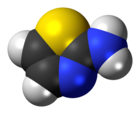
| |

| |
| Names | |
|---|---|
| Preferred IUPAC name
1,3-Thiazol-2-amine | |
| Other names
2-Thiazolamine, Aminothiazole, 2-Thiazylamine, Basedol, 2-Thiazolylamine, 4-Thiazolin-2-onimine, 2-Amino-1,3-thiazole, Abadole
| |
| Identifiers | |
3D model (JSmol)
|
|
| ChEBI | |
| ChEMBL | |
| ChemSpider | |
| ECHA InfoCard | 100.002.284 |
| EC Number |
|
| KEGG | |
PubChem CID
|
|
| UNII | |
CompTox Dashboard (EPA)
|
|
| |
| |
| Properties | |
| C3H4N2S | |
| Molar mass | 100.14 g·mol−1 |
| Appearance | Light yellow crystals |
| Melting point | 86 to 89 °C (187 to 192 °F; 359 to 362 K) |
| Boiling point | 117 °C (243 °F; 390 K) (20 hPa) |
| 100 g/L (20 °C) | |
| -56.0·10−6 cm3/mol | |
| Hazards | |
| GHS labelling:[1] | |

| |
| Warning | |
| H302, H319 | |
| P264, P264+P265, P270, P280, P301+P317, P305+P351+P338, P330, P337+P317, P501 | |
| NFPA 704 (fire diamond) | |
| 600 °C (1,112 °F; 873 K) | |
Except where otherwise noted, data are given for materials in their standard state (at 25 °C [77 °F], 100 kPa).
| |
2-Aminothiazole is a heterocyclic amine featuring a thiazole core. It can also be considered a cyclic isothiourea. It possesses an odor similar to pyridine and is soluble in water, alcohols and diethyl ether. 2-Aminothiazole itself is mainly of academic interest, with few exceptions. It is a precursor to a sulfathiazole ("sulfa drugs"). 2-Aminothiazole can be used as a thyroid inhibitor in the treatment of hyperthyroidism.[2]
2-Aminothiazole is prepared from paraldehyde, thiourea, and sulfuryl chloride.[3]
- ^ "2-Aminothiazole". pubchem.ncbi.nlm.nih.gov. Retrieved 12 December 2022.
- ^ Dahlmanns, Simone M.; Müller-Gärtner, Hans-Wilhelm (2000). "Thyrotherapeutic Agents". Ullmann's Encyclopedia of Industrial Chemistry. doi:10.1002/14356007.a27_039. ISBN 9783527303854.
- ^ Erlenmeyer, H.; Herzfeld, L.; Prijs, B. (1955). "Zur Synthese von 2-Amino-thiazolderivaten". Helvetica Chimica Acta. 38 (5): 1291–1294. doi:10.1002/hlca.19550380529.
